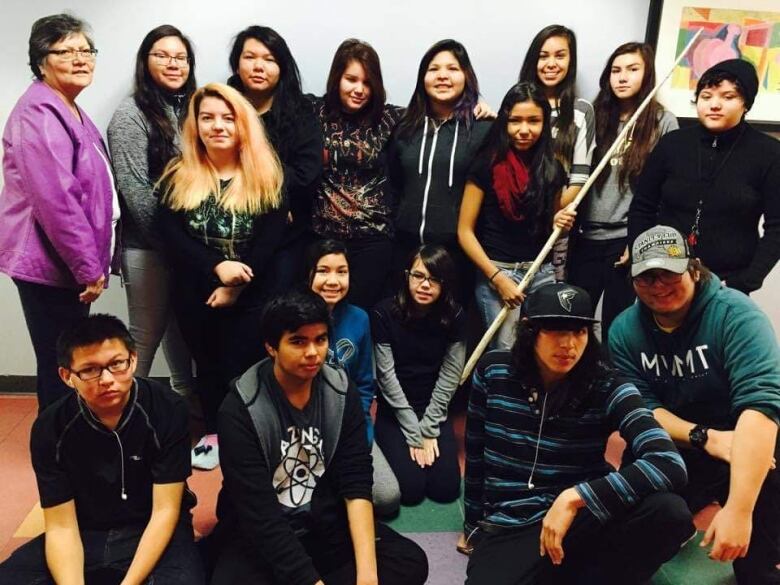Meet some Anishinaabemowin speakers who are passing on the language to the next generation
Whether native speakers or learners themselves, Anishinaabemowin teachers work hard to create curriculums, deliver online classes and build software to ensure the language is passed on to the next generation.
Despite the roughly 28,000 people who speak the Anishinaabe language across Ontario, Quebec and Manitoba, teaching materials for the language are limited.
When Sandra Peltier, of Wiikwemkoong First Nation in northern Ontario, started to teach her Indigenous language in Wiikwemkoong schools in 1986, she had to start from scratch.
“I got to my office and there was nothing for me to use,” she said.
“I was overwhelmed by the number of things that needed to be done and created. But through that, I fell in love with teaching my language, and I developed a passion for it.”

For 36 years, Peltier has developed teaching materials and resources for Anishinaabemowin. Today, she works with a council of elders and a team of graphic designers to standardize the language curriculum in the schools of her community.
Jessica Shonias also feels she “had to start from scratch” to develop teaching materials.
Every week, she logs on to teach Anishinaabemowin online to the staff members of Niiganiin Services, a community service organization with the North Shore Tribal Council, which includes seven First Nations along the north shore of Lake Huron.
“I mostly teach the staff,” Shonias said.
“The idea is that it will trickle down into the community. The North Shore First Nations also need to see that the staff working to serve them is walking the talk, so to speak.”
She said it’s difficult. The reality is studying and working nine to five is not conducive to picking up an endangered language. It’s not like French or Spanish.

Another challenge is teaching the language while being a learner.
“I would prefer a fluent speaker to be a teacher over myself, but the reality is that a lot of these teaching positions aren’t being filled,” Shonias said.
Blair Beaucage grew up hearing the language spoken by elders in his community, but did not become fluent until he was much older.
“I always wished I could speak it, and decided to learn it so I could teach my children,” he said.

A teacher from Nipissing First Nation in northeastern Ontario, Beaucage now splits his time between learning the language and sharing it with others on Zoom.
“When I had my first child, I could speak with her to a certain point, but I couldn’t go as far as I’d like,” he said. “So I set time aside every day for learning, trying to make it work.”
The median age of native speakers of Anishinaabemowin is somewhere between 60 and 80 years old, according to Shonias.
It’s a fact Sandra Peltier, a first-language speaker, is well aware of.
“When I go back to the spirit world, I will be taking my language with me. I want to make sure to instill, pass on and share my knowledge,” she said.
Sometimes, it feels like the language is on life-support.– Blair Beaucage, teacher
Peltier believes that for the language to have a real future, immersion programs are needed in schools.
As Blair Beaucage looks around his community in Garden Village, by Lake Nipissing, he shares stories of the past.
“About 70 years ago, everyone here talked Ojibway. Today, very few people speak it,” he said.
“I don’t think the [community of learners] is growing fast enough right now to retain the language. There needs to be some big changes. Sometimes, it feels like the language is on life-support.”
Beaucage believes online teaching has potential.
“We’ve discovered that we can reach more students, across a wider territory.”
“Anishnaabemowin is an earth language. We cannot teach it like we teach English”, said Peltier.
“Our language is 80 per cent action words. We need to be in immersion, in action, for the [gist] of the words used to be understood.”

Jessica Shonias, of Chippewas of Rama First Nation in Ontario, did not grow up fluent. She took language courses through her schooling, but an Anishinaabemowin immersion camp in Minnesota was the turning point for her.
“No English whatsoever,” she said.
“No devices, no social media, no English names. I suffered for three weeks — arguably, I wasn’t ready, but I survived, and that’s when things really started to click.
“It honestly felt like a miracle, after many years of classes and little progress, I reached a point where I had come too far to turn around.”
Enthusiastic, growing community of learners
In his full-time job as a scientist in a geriatric care centre, Jed Meltzer uses language software to maximize his patients’ ability to memorize vocabulary and grammar.
“I think language software are underutilized resources in language revitalization,” said Meltzer, a senior scientist at Baycrest Geriatric Care Centre in Toronto.

“I memorized over 2,500 words [using a software]. I thought I should show others, because it’s working very well.”
With the help of three other language specialists, Meltzer developed an Anishinaabemowin course that can be used with language-learning software.
He said he believes this learning technique is particularly effective for adult learners.
“With Indigenous languages, there’s been a loss of intergenerational transmission”, Meltzer said.
“There are first-language speakers who are quite elderly; their grandchildren might be lucky enough to be in a bilingual program in school. The parents, the generation in between, they are kind of getting left out, there are no resources for them.
“For a language to thrive, it needs to be spoken by the family”, he added.
He also said there is a lot of appetite for learning the language in non-Indigenous communities.
“I always say, tongue in cheek, the price of putting this online is that a bunch of nerdy white guys will use it too. I don’t think it’s a bad thing – the more people speaking it, exchanging about it, the more it will thrive.”
For Shonias, interest from English-speaking communities is key.
“Everyone should be learning it, not just every Anishinaabe person. If you’re on Anishinaabe territory, you should be speaking the language of that place,” she said.
“The time to go to class and pick this up, was, frankly, yesterday.”





